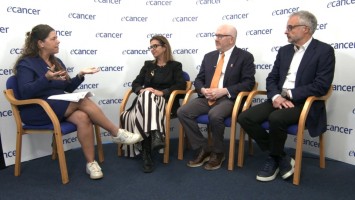Atezolizumab with platinum-based CT and niraparib show no improvement in survival for rOC
Dr Antonio Gonzalez Martin - Cancer Center Clínica Universidad de Navarra, Madrid, Spain
The ANITA trial is a randomised phase III placebo controlled trial that was led by the GEICO group and the ENGOT group. It’s an international study that explored the addition of atezolizumab to a standard combination of platinum-based chemotherapy followed by maintenance niraparib in patients with recurrent ovarian cancer and a treatment-free interval platinum longer than six months.
The background of this study is that we have a strong rationale for combining PARP inhibitors and checkpoint inhibitors in ovarian cancer, but the contribution of this specific combination to the ovarian cancer was not known. We had data of the triplet combination in first line of bevacizumab plus checkpoint inhibitor plus PARP inhibitor that produced a benefit but the individual contribution of this PARP inhibitor plus anti-PD-L1 was not well known.
So we randomised 417 patients to standard chemo followed by maintenance niraparib if the patient did not progress, that was the control arm. In the experimental arm we added atezolizumab both in the chemotherapy phase and in the maintenance phase. Patients needed to have up to two prior chemotherapy lines, the last one with platinum, a treatment-free interval of platinum longer than six months and a mandatory biopsy before entering the study because one of the stratification factors was PD-L1 positive.
The study included, as I said, 417 patients during a period of approximately 2½ years. The arms were well balanced; most of the patients had only one prior line of chemotherapy. 14% had BRCA mutation; one third had PD-L1 positive and most of the patients, two-thirds, had a treatment free interval of platinum longer than one year.
In this case, the addition of atezolizumab did not improve significantly the median progression free survival. The hazard ratio was 0.89 and we did not observe that those patients with PD-L1 positive tumours had an additional benefit of atezolizumab. We also looked at the effect of atezolizumab only in the patients that started the maintenance phase. We observed a slight separation of the curves with a hazard ratio of 0.8 that, again, was not statistically significant.
In terms of safety, we have not observed new signals related to atezolizumab or niraparib – the safety profile was as expected.
So what are the conclusions of this study? The addition of anti-PD-L1 to PARP inhibitor and to chemotherapy in the relapsed setting did not improve the progression free survival. But this is very important information to understand, to interpret the trials with checkpoint inhibitors in the first line in which checkpoint inhibitors are combined with PARP inhibitors plus or minus bevacizumab. It seems that for checkpoint inhibitors to work, it is needed also the antiandrogenic agent on top of the PARP inhibitor plus the checkpoint inhibitor plus bevacizumab. Thank you very much.








